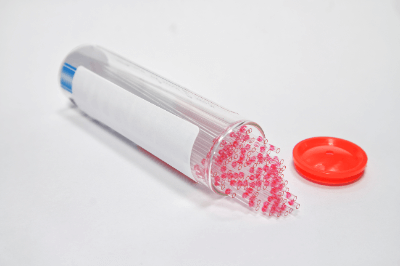What Is a Hematocrit Capillary Tube?
 A hematocrit capillary tube is an instrument used in blood testing.
A hematocrit capillary tube is an instrument used in blood testing.
Blood is composed of cellular components: blood cells (red blood cells involved in oxygen transport and white blood cells involved in the body’s immune defense) and platelets, and plasma, the liquid component that suspends these cellular components. In healthy human blood, the majority of cellular components are red blood cells. Red blood cells contain hemoglobin (Hb), which gives blood its red color and oxygen-binding capacity.
Plasma is composed primarily of water (about 93%), with other components including salts, various proteins, lipids, and sugars (e.g., glucose). The hematocrit, or the percentage of red blood cell volume in the blood, is sometimes determined during a blood test. For example, it can be used as an indicator of anemia. Anemia is a thinning of the blood, and hematocrit is used as an indicator of this condition.
The hematocrit capillary tube is the instrument used to measure this hematocrit.
Uses of Hematocrit Capillary Tubes
Hematocrit capillary tubes are primarily used to measure hematocrit in blood tests. It is also sometimes used to obtain small amounts of plasma in animal experiments.
1. Measurement of Hematocrits
Hematocrit measurements may be performed when anemia, dehydration, bleeding, or other medical or surgical conditions are suspected. A low hematocrit reflects a low number of circulating red blood cells and is an indicator of reduced oxygen-carrying capacity or overhydration.
Examples of conditions that can cause low hematocrit (anemia) include.
- Internal or external bleeding – hemorrhage
- Complications of Chronic Renal Failure – kidney disease
- Pernicious anemia – vitamin B12 deficiency
- Hemolysis – associated with transfusion reaction
- Autoimmune diseases and bone marrow failure
A high hematocrit may reflect an absolute increase in red blood cell count or a decrease in plasma volume.
- Severe dehydration – e.g., in cases of burns, diarrhea, or excessive diuretic use
- Erythrocyte Excess – erythrocyte Excess
- Viral polycythemia vera – abnormal increase in blood cells
- Hemochromatosis – inherited disorder of iron metabolism
- Indicators of overdose of exogenous erythropoietin (EPO), which stimulates red blood cell production
2. Animal Experiments
Because of its ability to collect very small amounts of blood and to obtain plasma by centrifugation, it is sometimes used to obtain minute amounts of plasma, mainly from animals (micro sampling).
Principle of Hematocrit Capillary Tubes
The most commonly used hematocrit capillary tube is a capillary tube (capillary tube) with a heparinized inner surface. Untreated (plain) capillaries are also available.
When one end of the capillary tube comes in contact with the collected blood, the blood is sucked into the capillary tube by capillary action. At the same time as the blood is sucked up, the heparinized blood is anticoagulated with heparin.
The capillary is then centrifuged to separate the blood cells from the plasma. The hematocrit is determined from the length of the blood cell portion (erythrocyte column), which appears red, and the plasma portion, which appears colorless to pale yellow (in humans).
Other Information on Hematocrit Capillary Tubes
1. Definition of Hematocrit
Hematocrit is defined as the ratio of red blood cell volume to total blood volume, also known as packed cell volume (PCV). When heparinized blood (heparin is an anticoagulant) is centrifuged, the red blood cells become packed at the bottom of the tube and the plasma remains as a clear liquid at the top. The ratio of this volume of packed red blood cells to the total blood volume is the hematocrit.
Hematocrit is reported as a percentage or ratio. In healthy adults it is about 40-48%, but in newborns it can reach 60%.
The following is a summary of the abbreviations associated with discussing hematocrit.
- Hct: Hematocrit
- ctHb: total hemoglobin concentration
- Red Blood Cell (RBC)
- MCV: Mean cell volume
- MCHC: mean corpuscular hemoglobin concentration
2. How to Use It When Measuring Hematocrit
Seal
One end of the capillary must be sealed before centrifugation. If not sealed, centrifugal force will cause the blood to flow out. To seal the capillary, a special putty is used.
After the blood is sucked up, one end of the capillary is sealed by sticking one end into the special putty and allowing the putty to bite into the inside of the capillary. The sealed side should face outward, i.e., toward which centrifugal force is applied.
Scale Plate
To obtain a hematocrit value from the centrifuged blood sample in the capillary tube, refer to the scale plate. Move the scale down the sample until the bottom of the packed red blood cell column first lines up with the “0” line on the scale plate, then the top of the plasma column lines up with the “100%” line.
At this point, read the values at the border between the red blood cell column and the plasma column. The white layer, the layer between the red blood cell and plasma columns, makes up about 1% of the sample, but this layer is not included on the red blood cell side.
3. How to Use It as a Micro-Blood Sampler
A glass capillary tube is used, and the blood is collected and the sealed capillary tube is centrifuged as in normal use. The glass capillaries are used because they are folded in the process of centrifugation. After centrifugation, a scratch is made on the border between the blood cell column and the plasma, slightly closer to the plasma, with a glass cutter, and the capillary is folded.
The broken capillary is placed in a collection vessel (e.g., microtubes) and centrifuged to collect the plasma in the vessel. Since this method is difficult to perform, recently, a special device for micro-sampling has been developed.